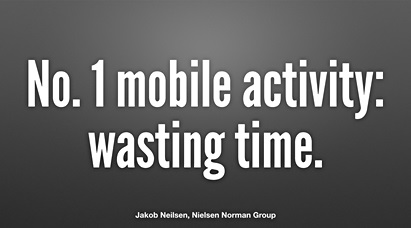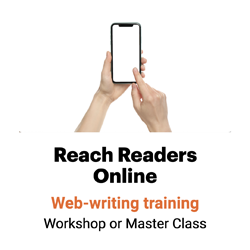Web visitors ‘get visibly angry’ at verbose sites
Here’s an interesting dichotomy: Killing time is the killer app for mobile devices. But mobile users are in a hurry and “get visibly angry” at verbose sites that waste their time.

Why?
“Even relaxation is purposeful behavior,” according to usability expert Jakob Nielsen. “In information foraging theory, users seek to maximize their cost/benefit ratio. That is, people want more thrills and less interaction overhead.”
Sadly, interaction costs are inherently greater in mobile — all that swiping and scrolling and trying to remember what you can’t see on the screen adds up.

“Tolerance of padding on mobiles is a lot lower,” counsels the BBC in its writing news for mobile screens guidelines. “So people are even quicker to drop out. You have to get their attention instantly; grab them from the first sentence. It’s too easy to click away.”
So how do you give mobile readers more thrills and less interaction overhead? Cut the blah-blah. Readers won’t put up with filler on their phones.
Cut the blah-blah.
Nielsen once saw this electronic sign in an airport hotel lobby:
and Convenience
The Monitor
Underneath Will
Indicate the Flight
Schedules of All
Airlines at JFK
Really?! you might ask. This flight monitor will actually … monitor flights?
“Because the monitor’s meaning is obvious to anyone who has ever been on an airplane, the sign adds nothing,” Nielsen says. “Worse, it wastes people’s time as they ponder the cycling text, assuming that it will eventually say something important.”
After all, Nielsen points out, the sign could just say:
JFK Flights
Avoid information pollution.
Call it information pollution — “excessive word count and worthless details” that make it hard for people to get good information.
Information pollution not only wastes time, it steals audience attention.
“Each little piece of useless chatter is relatively innocent, and only robs us of a few seconds,” Nielsen says. “The cumulative effect, however, is much worse: we assume that most communication is equally useless and tune it out, thus missing important information that’s sometimes embedded in the mess.”
So cut the fluff.
“In particular, ditch the blah-blah verbiage,” Nielsen says. “When writing for mobile users, heed this maxim: If in doubt, leave it out.”
Filler = bad.
Nielsen also sees this kind of “useless chatter” at the tops of many web pages.
“The worst kind of blah-blah has no function; it’s pure filler — platitudes, such as, ‘Welcome to our site, we hope you will find our new and improved design helpful,’” he says.
“Kill the welcome mat and cut to the chase.”
Filler of all kinds irritates mobile readers. Consider this response from one participant in Nielsen’s mobile usability studies:
“This is what came to me as breaking news? That’s too much. It should be: This is what happened, and this is what’s going on.”
She felt duped because she didn’t get enough payoff from her investment of time and effort.
Cut to the chase.
“Let’s clean up our information environment,” Nielsen says. “Are you saying something that benefits your customers, or simply spewing word count? If users don’t need it, don’t write it. Stop polluting now.”

Cannot argue with the logic of this article but it does, in my mind, refute the current backlash against the inverted pyramid that is common on this webstie. There is a place for feature leads that meander around, but for the vast majority of business writing, surely “get to the point” should be the imperative. And nothing gets to the point like the inverted pyramind.
The inverted pyramid is one way to get to the point faster. But it’s been proven in the lab to not work well with readers, as you’ve read often here. So we look for other ways, such as a deck, or a one-sentence summary under a headline.
This piece argues against leading with blah-blah text. The feature-style story structure demands that you start concretely, so no blah-blah leads there (if you’re doing it right).
And, if your feature lead meanders around, you’re not doing that right, either.